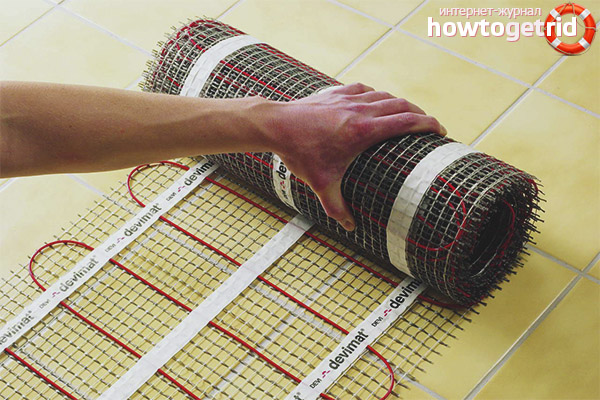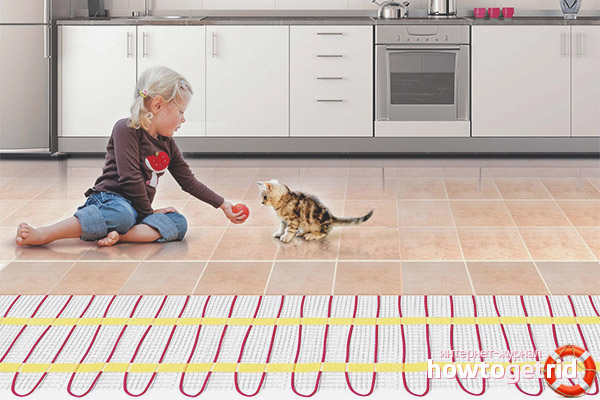The content of the article
Warm electric floor - a unique engineering design that allows you to heat the entire room, perfectly complementing other heating systems. In some cases, the underfloor heating even becomes the only heating element. You can use this design not only in houses, but also in other repaired premises.
Most often, warm floors are used in rooms where the floor is laid with porcelain stoneware or tiles. In addition, it is extremely rare that an electric floor is used without a central heating system. Typically, these designs complement each other. The electrical system helps warm the cold floor. Most often, tiles or porcelain tiles are laid out in the bathroom, in the kitchen or in the corridor, therefore, warm floors are often used in these areas.
It is worth noting the obvious advantage of a warm floor - heating the air to a height of 2.5 meters from the floor. The warm air in the room makes the living conditions in it even more favorable and comfortable.
Particular attention should be paid to the installation process of the electric floor. It is highly discouraged to save on materials, even if it seems that the difference will be insignificant. It is best to entrust the installation to professionals.
Advantages of installing underfloor heating
Electric heated floors today are very popular for a number of reasons:
- The design of the electric floor is able to eliminate the lack of central heating in the apartments. As a rule, the main heating in modern homes least of all heats the floor, leaving it pretty cold. This is due to the fact that the batteries are located at a certain distance from the floor, as a result of which cold air accumulates at the bottom. Warm floors help solve this problem. As a result of the installation of an additional design, the heating of the room becomes uniform.
- Installation of a warm floor does not require the use of additional equipment, which makes it possible to install such a design in any room.
- The degree of floor heating can be easily controlled by choosing the most optimal option for yourself.
- A warm electric floor is complemented by a special temperature controller, which allows you to set the required temperature in each room. In some areas, you can also easily turn off the heating altogether.
- Warm air rises from the floor, thereby eliminating the formation of drafts in the apartment or house.
- The electric floor allows you to save any room from excess moisture, which, in turn, eliminates the likelihood of mold.
- Warm flooring can easily be made the main source of heating in the house, thus getting rid of batteries that take up additional space and collect a lot of dust on themselves.
- The electric floor is a rather reliable design, which is extremely rare to fail. If the installation process went right - in accordance with the instructions, then damage is unlikely to appear. Most often, problems with underfloor heating appear only in those cases when a breakdown or damage occurred due to the fault of the owner. For example, if a nail was driven into one of the elements of the system. If some kind of malfunction nevertheless arose, do not worry and panic, since any electric floor can be easily repaired. If you can’t do this on your own, you can contact the service center.
- The underfloor heating system is absolutely safe and resistant to moisture. Thanks to this design, you can create warmth and comfort in the house.
- The design of the warm electric floor is compact and convenient, so it does not reduce the height of the ceiling in the room.
- All structural elements of the warm floor are well hidden from the eyes, which makes the system invisible and neat.
- Installation of the structure is quite simple, even a person without special experience can install all the equipment and the system as a whole.
- With the help of a warm floor, the surface in the house is heated evenly and equally everywhere.
Disadvantages of the electric floor
Despite the large number of advantages of the construction of a warm floor, this system still has some disadvantages:
- The first and most obvious minus of the electric floor is the increase in energy costs in the house. In this case, in order to reduce costs as much as possible, it is best to use a temperature controller that will lower the temperature or turn off the heating in some areas.
- The second drawback is also associated with significant costs. The fact is that a warm floor is an expensive construction, which also requires certain costs for its installation.
- Before installing the design of the electric floor, it is necessary to change the wiring in the house. Such a system significantly increases the load on the electrical system, so old wiring may simply not withstand.
- The design of the warm floor is very demanding on the floor covering. It must possess, first of all, good thermal conductivity, so that the efficiency of the system is felt. If there is a carpet or rug on the floor that does not allow heat well enough, the effectiveness of the warm floor will not be great.
- Some types of flooring may be affected by the use of a warm electric floor. The greatest impact is on the wooden floor, as the wood heats up when heated, and then begins to change shape.
- If the floor covering is also varnished on top, the heating temperature may not exceed more than 21 degrees.
- In order to save energy and costs as much as possible, a warm floor, as a rule, is not installed in places where furniture is standing. In this regard, the rearrangement of furniture in the house will also entail the reinstallation of the construction of the warm floor.
- The use of a heated floor in a house provokes the appearance of electromagnetic radiation. Of course, today everyone uses electric devices, despite the propagation of electromagnetic waves, however, with the installation of an additional electric system, the radiation is amplified, so this factor must be taken into account.
- The use of any electric heater, including the electric floor, entails an increase in the risk of electric shock. This factor should be considered, especially in rooms with high humidity.
It is worth noting that, despite all these shortcomings, most people still use underfloor heating in the house, since for them such systems are a prerequisite for a comfortable stay. Moreover, most of these shortcomings are completely insignificant and easily eliminated. As for the additional costs, as a rule, everyone understands that comfort is worth the extra money.
The advantages of electric underfloor heating over water
Electric underfloor heating is used much more often than water. This is easily explained, since such a design has several advantages:
- Electric underfloor heating is much easier and more convenient to regulate in terms of temperature than water. It is enough to use just a thermostat, with which you can set the desired temperature and do it much more accurately than in a water system.
- Installation of cables in the electrical construction of a warm floor is much simpler and faster than water pipes in a water heating system.
- The use of a water system of a warm floor entails the installation of a gas boiler for heating water. This measure requires additional space, as well as an increase in installation costs.
Thus, it can be determined that the electric floor heating is very convenient to use. It is especially suitable for heating small rooms, such as an apartment or a small country house. Also, the design of the warm electric floor is great for the office, since in such a room it is far from always possible to install a gas boiler.
Disadvantages of electric underfloor heating versus water
Unfortunately, the electric underfloor heating system also has some disadvantages in comparison with the water structure:
- Often a water heated floor becomes a more economical option than an electric one. Such savings are especially noticeable in large areas.
- Using hot water for floor heating and space heating is a safer option than using electricity. Hot water can harm a person to a lesser extent than electric current.
- The water heating design can last much longer than the electrical system. According to the most popular manufacturers of such systems, the water floor can last up to 50 years in the house.
The use of a water floor is best suited for heating large rooms. For example, it is better to use it in large country houses or in working areas.
Electric floor - a unique modern design that allows you to create maximum comfort in the house. With such a system, your floor will always be warm, which will not only allow you to walk barefoot, but also allow children to play on the floor, without fear that they will blow through a draft. Moreover, the design is absolutely safe, the system perfectly protects all elements from the ingress of water and other objects.
Video: which electric underfloor heating is better?











Submit